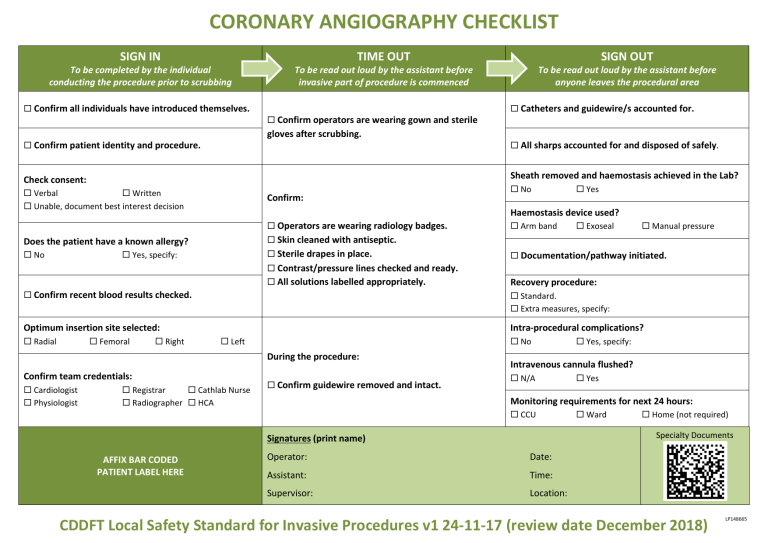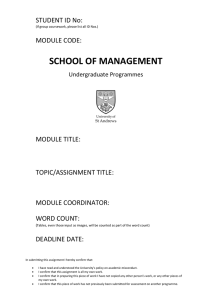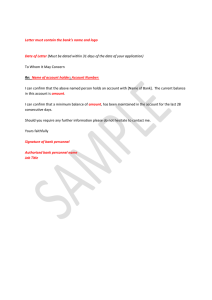
CORONARY ANGIOGRAPHY CHECKLIST SIGN IN To be completed by the individual conducting the procedure prior to scrubbing Confirm all individuals have introduced themselves. TIME OUT To be read out loud by the assistant before invasive part of procedure is commenced Confirm operators are wearing gown and sterile gloves after scrubbing. Confirm patient identity and procedure. Verbal Written Unable, document best interest decision Confirm: Operators are wearing radiology badges. Sterile drapes in place. Yes, specify: Contrast/pressure lines checked and ready. All solutions labelled appropriately. Confirm recent blood results checked. All sharps accounted for and disposed of safely. Femoral Right No Haemostasis device used? Arm band Exoseal Manual pressure Documentation/pathway initiated. Recovery procedure: Intra-procedural complications? Left No During the procedure: Confirm team credentials: Registrar Cathlab Nurse Radiographer HCA Confirm guidewire removed and intact. Yes, specify: Intravenous cannula flushed? N/A Yes Monitoring requirements for next 24 hours: CCU Ward Home (not required) Specialty Documents Signatures (print name) AFFIX BAR CODED PATIENT LABEL HERE Yes Standard. Extra measures, specify: Optimum insertion site selected: Cardiologist Physiologist Catheters and guidewire/s accounted for. Skin cleaned with antiseptic. Does the patient have a known allergy? Radial To be read out loud by the assistant before anyone leaves the procedural area Sheath removed and haemostasis achieved in the Lab? Check consent: No SIGN OUT Operator: Date: Assistant: Time: Supervisor: Location: CDDFT Local Safety Standard for Invasive Procedures v1 24-11-17 (review date December 2018) LP148665 CORONARY ANGIOGRAPHY CHECKLIST This LocSSIP applies to all coronary angiogram procedures undertaken in the CDDFT Cardiac Catheter labs. Must-do procedural steps 1. To ensure compliance with best practice: a. CDDFT’s angiography pathway and procedural checklist must be used. 2. To reduce the risk of bleeding: a. Manual pressure, pressure clamps or angioseal devices should be used as appropriate. b. Any clotting abnormalities should be corrected if appropriate. 3. To eliminate the risk of guidewire retention (A NEVER EVENT): a. When the needle, dilatator or catheter is being inserted or manipulated, part of the guidewire, if present, must be visible and held by the individual performing the procedure. b. Confirmation of guidewire removal must take place and be recorded as indicated in the TIME OUT. 4. To reduce the risk of catheter-related infections: a. The insertion site must be cleaned with betadine or 2% chloraprep in 70% alcohol. b. The operator must fully ‘scrub’ and must be wearing a gown and sterile gloves throughout the procedure. 5. To reduce the risk of unrecognised cardiac arrhythmias: a. Continuous ECG monitoring must be undertaken during insertion. 6. To reduce risk of injection of incorrect solution: a. All solutions must be properly labelled and checked before administration. 7. To ensure that residual sedative drugs do not remain in the cannula following the procedure: a. Any cannula used during the procedure must be flushed before the patient leaves the procedural area. Associated guidelines: Acute and Emergency Care Area LocSSIP describing all NatSSIP principals which apply to this invasive procedure and checklist. CDDFT Local Safety Standard for Invasive Procedures v1 24-11-17 (review date December 2018)



